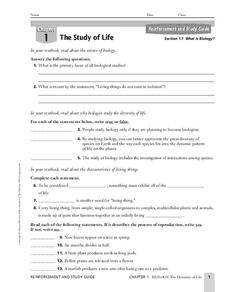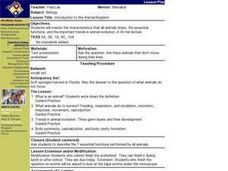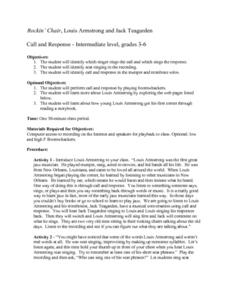Curated OER
Animal Behavior
Can you train a worm? Biology buffs will have a blast trying! Using planaria or earthworms, they introduce a certain stimulus repeatedly until the desired response happens more quickly. They also explore the response of their own eyes to...
Curated OER
Reading Response Questions
In this readers response worksheet, students are posed 37 questions in response to a passage they've read. Students must write short responses to each thought provoking question regarding characters, events, and author's purpose among...
Curated OER
HELP! HELP! SOMEONE IS HURT!
Students study a programmed response to any emergency situation that they may encounter during physical education classes without pandemonium breaking out.
Curated OER
What is Biology?
In this science of biology worksheet, students will review the concepts relating to biology including the characteristics of living things, the process of reproduction, adaptations, and evolution. This worksheet has 5 short answer, 3...
Curated OER
The Nervous System
In this nervous system worksheet, students ball up a piece of paper and stand in front of a friend and gently toss the paper ball at their face. Then they describe their friends response and why they actually responded to the paper ball.
Curated OER
Introduction to the Animal Kingdom
Students are asked: Are there animals that don't move during their lives. They are asked what is an animal? Students discuss what animals need to survive. They are taught the trends in animal evolution. Students discuss the three...
Curated OER
Stimulus/Response in Invertebrates
Students design and conduct and experiment to determine how invertebrates react to an outside stimulus such as light and other stimuli. Student must develop a clear plan of action, collect data in an organized manner and analyze their...
Curated OER
Rockin' Chair, Louis Armstrong and Jack Teagarden
Students examine the life and music of Louis Armstrong, the first great jazz musician. The musical techniques of call and response is listened to and then copied in musical conversations in this lesson.
Curated OER
The Art and Writing of Estelle Ishigo, Heart Mountain Internment Camp, 1942-1945
Students view images of the Heart Mountain Internment Camp created by Estelle Ishigo. They discuss the time and place portrayed in the images and create a timeline recording events related to the internment of Japanese Americans.
Curated OER
Learning Word Search
In this biology worksheet, students identify and locate each of the vocabulary terms listed to the right related to psychological terms. There are 17 biology terms located in the word search.
Curated OER
Lord, How Long Wilt Thou Be Angry?
Students listen and respond to a piece of Christian music. They decide what the mood of the piece is, where does it climax and what musical techniques were used by Purcell to create tension in the musical example.
Curated OER
Sanctus--Frank Martin
Twelfth graders complete a music listening log and then work in small groups to complete essays that answer a given set of questions about the music.
York University
Classics in the History of Psychology: Behaviorism the Modern Note in Psychology
"Behaviorism--The modern Note in Psychology" written by John B. Watson in 1925 was an important paper in the development of Behaviorism in Psychology. It is reproduced in full here.
PBS
Pbs Learning Media: Chalk Sculpture
In this video segment from Art in the 21st Century: Paradox, two artists create a public art piece using giant pieces of chalk.
Science Buddies
Science Buddies: Project Ideas: Plants on the Move: Phototropism
A plant biology science fair project exploring how various levels of light affect plant growth. The Science Buddies project ideas are set up consistently beginning with an abstract, objective, and introduction, followed by a section on...
Science Buddies
Science Buddies: Slimey Likes It! Studying Chemotaxis in Physarum Polycephalum
In this biology science fair project, test various amounts of glucose to see which ones attract and which repel (chemotaxis) growing Physarum polycephalum slime mold.
Science Buddies
Science Buddies: Plants Are on the Move! A Study of Gravitropism
As we humans zip from place to place, we often forget to stop and smell the roses. Compared to our fast-paced lifestyle, plants seem rooted to the spot. Don't be deceived by appearances however, plants are on the move. This experiment...
Polk Brothers Foundation Center for Urban Education at DePaul University
De Paul University: Center for Urban Education: Constructed Response Organizer [Pdf]
This graphic organizer contains questions for students as they analyze a constructed response question. Students will read the question closely and use this planning tool to plan constructed responses. This graphic organizer is a...
University of Hamburg
University of Hamburg: Phototropism
A high level discussion of the phototropic effect in plants. Discusses the basics, but quickly branches into a very high level discussion.
University of Hamburg
University of Hamburg: Photoperiodism and Stimulation
A good summary of the photoperiodic effects of plants. Discussion of the way that the length of the day effects the growth of plants.
Ibis Communications
Eyewitness to History: The San Francisco Earthquake, 1906
This article offers moving eyewitness accounts of events and feelings of the 1906 San Francisco earthquake.
CK-12 Foundation
Ck 12: Characteristics of Life
[Free Registration/Login may be required to access all resource tools.] Videos, texts, activities, and assessments about the factors that characterize living things.
PBS
Pbs: El Nino
You can link to the anatomy of El Nino, chasing El Nino, and El Nino's reach. There is a resource page and a search page.
National Cancer Institute at the National Institutes of Health
Seer Training Modules: Introduction to the Nervous System
Self-guided learning activity where students learn about the structure and function of the human nervous system. There is a short quiz at the end of the lesson to check for understanding.





















